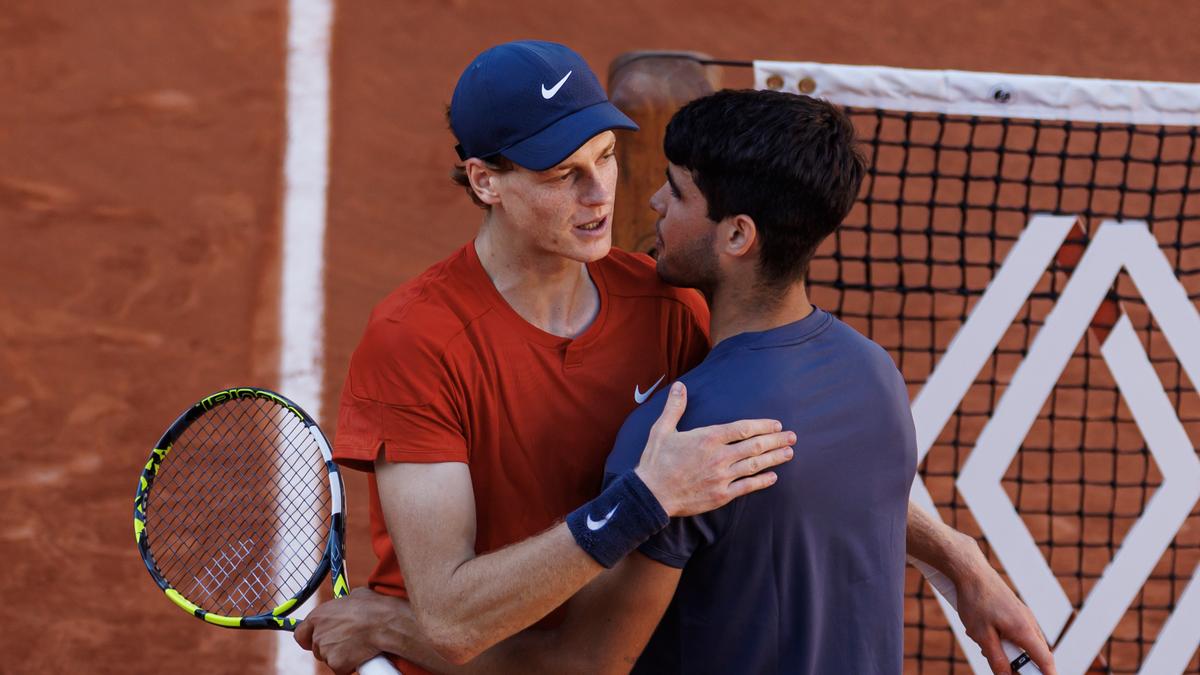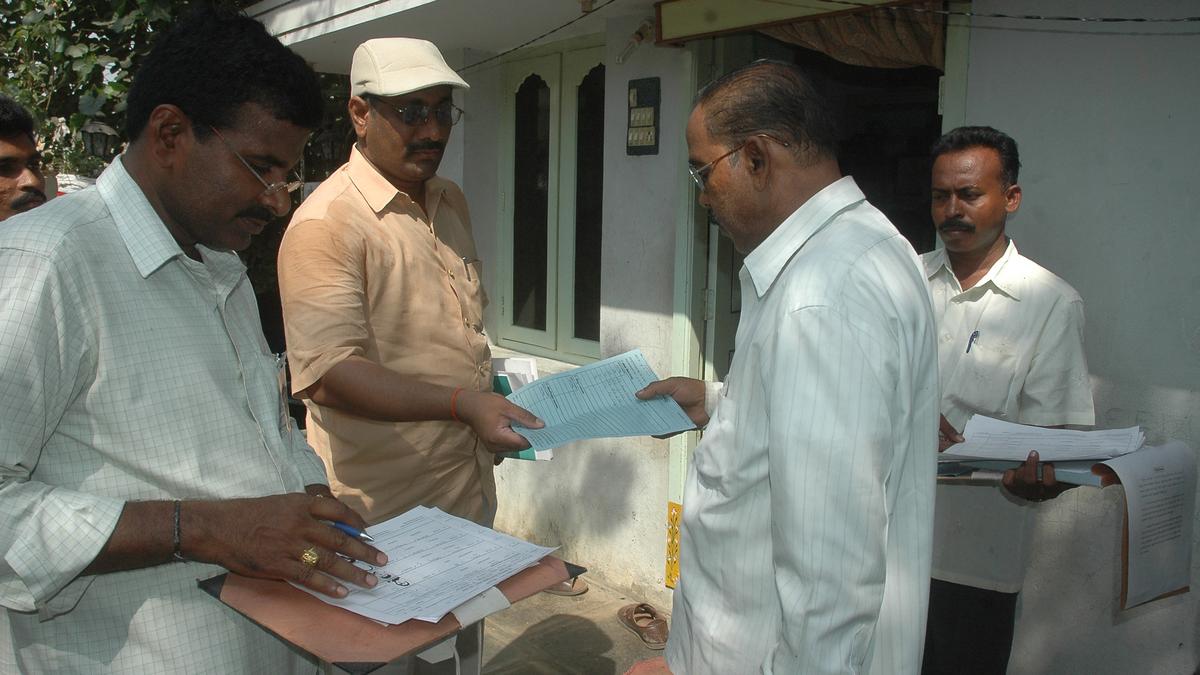In the autumn of 2022, when 20-time Major winner Roger Federer announced his retirement, the world of tennis slipped into a state of near-eternal lament. There was the disappointment of not being able to watch one of the greatest players live anymore, but it was also about the end of the famed 40-match Federer-Rafael Nadal rivalry which had defined the sport.
Nadal, by then, had started hobbling again because of multiple injury setbacks and, in a curious twist of fate, did not go on to add to his then record 22 Majors. The other member of the ‘Big Three’, Novak Djokovic, was — and still is — around, prancing his way to the biggest titles, but the sport had seemingly lost the emotional hook that fans had hung on to for a good part of the previous two decades.
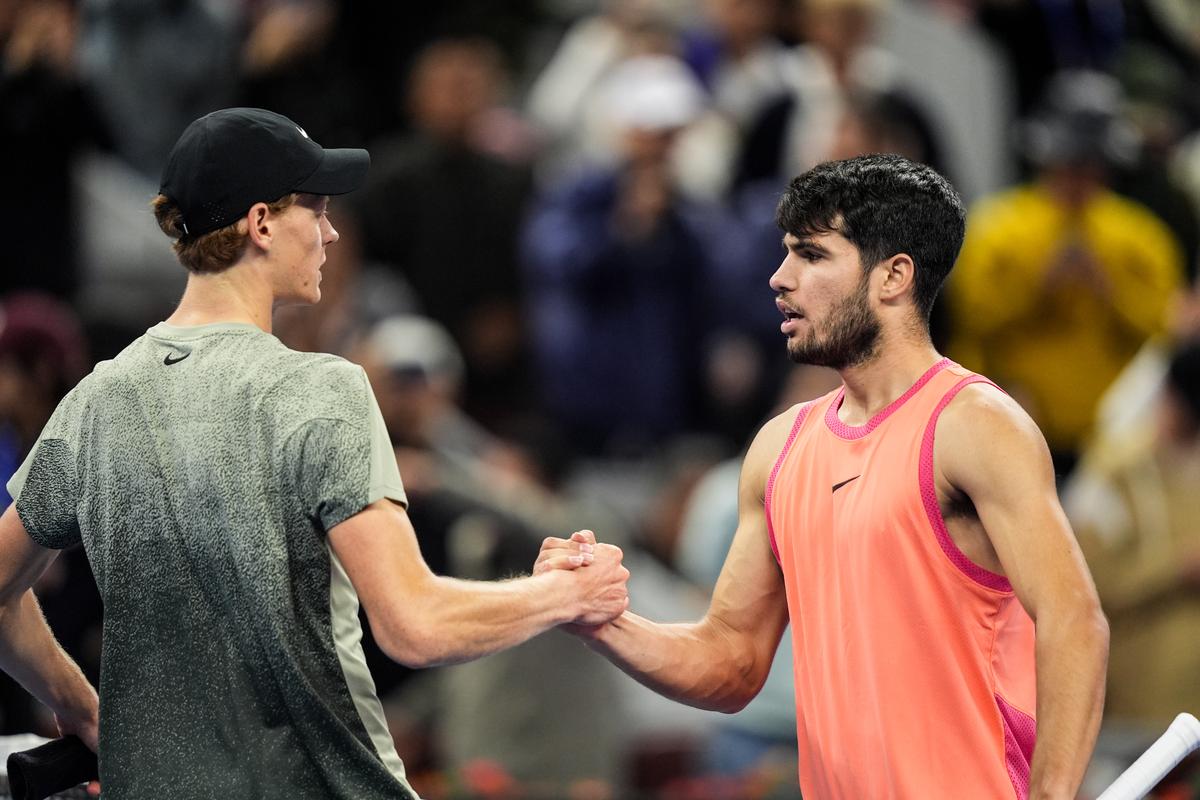
Carlos Alcaraz, right, may have the head-to-head advantage over Jannik Sinner, but at no point has the match-up suffered from one-sidedness. The two are not limited by the dynamics of the surface, which broadens the scope of their rivalry.
| Photo Credit:
Getty Images
Changing equation
The Grand Slam tournaments — the crown jewels — where the ‘Big Three’ had long established fiefdoms, appeared ripe for new wannabe monarchs to battle it out. Men’s tennis was expected to be chaotic, capricious and full of surprises, a far cry for those who had grown accustomed to having at least two members — if not all three — of the ‘Big Three’ routinely at the business end of big-ticket events.
That none of this has come to pass thus far is primarily because of how seamlessly Carlos Alcaraz and Jannik Sinner have filled the space and established a firm duopoly. Blessed with great court-presence and fast-developing aura, they are now the top-two players in the world, and the match-up is 11 contests young, with Alcaraz leading 7-4.
The Spaniard, all of 22, and the Italian, 23, have accounted for seven of the 10 last Slams, including a clean sweep of the most recent five. There is indeed a churn one rung below, at the ATP Masters 1000 level, where 11 different victors have emerged in the last 16 tournaments. But the much anticipated — and feared — turmoil at the top has proved a chimera.
History suggests that rivalries thrive when there is a dint of differentiation — right versus left; attack versus defence; net-lover versus baseline-hugger; serve bot versus return machine. But in this era of homogenisation of courts, where clay and grass are closer than ever, a one-size-fits-all style is bringing increased levels of success, and sports science and improved nutrition techniques are universally accessible, such stark contrasts seldom exist.
Yet, the Alcaraz-Sinner duel works, primarily because of the sheer competitiveness the two bring to the table, the tactical excellence and subtle differences in playing styles. Of the two, Alcaraz is the more flamboyant, trick-shot-loving showman who treats the court as his own theatre of dreams. After winning his first Major on the hard courts at the US Open in 2022, he has gone on to master clay and grass and their abundant unpredictabilities, even completing the arduous French Open-Wimbledon double in 2024.
Sinner, in contrast, presents a staid and emotionless persona on court, and his repeatable technique is more suited for truer surfaces, as seen from the fact that he has won the last three Slams to be held on synthetic courts. Such has been his dominance that starting from the Toronto Masters in 2023, Sinner has won 13 of 20 hard-court events he has entered (including two Davis Cups) and finished runner-up in two others.
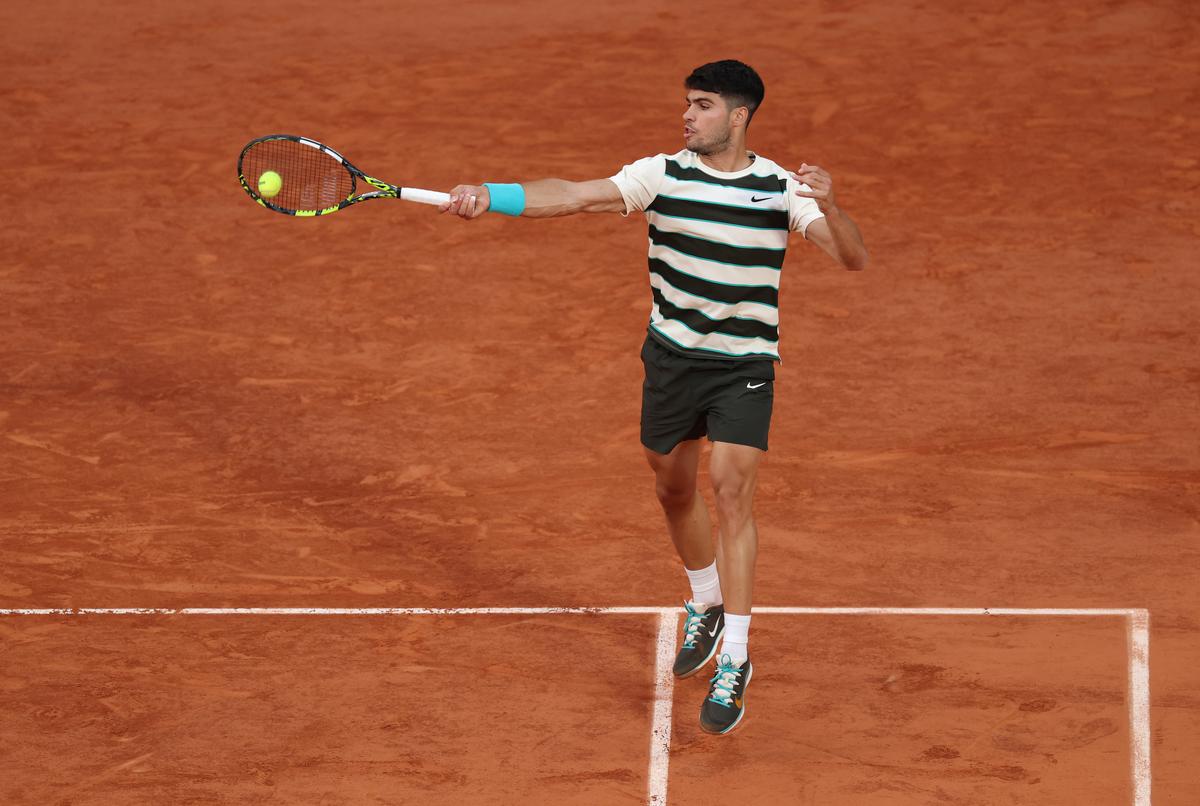
Limitless virtuoso: Alcaraz is a flamboyant, trick-shot-loving showman who treats the court as his own theatre of dreams. After winning his first Major on the hard courts at the US Open in 2022, he has gone on to master clay and grass.
| Photo Credit:
Getty Images
When ‘opposites’ collide
In the recent ‘Served with Andy Roddick’ podcast, former World No. 1s Andre Agassi and Roddick laid this out beautifully, with Agassi calling Alcaraz “still so raw” and Roddick likening Sinner to an “algorithm” and “a piece of software that went: input output input output”.
“It is amazing how little his speed diminishes on clay and grass,” Agassi said of Alcaraz. “Most people who are fast go to grass and their speed comes down 5% just because you have to be careful in the corners. But his doesn’t. I think he should maximise [his potential], and we should enjoy watching him before he maximises, because there is so much fun for the fan.
“Sinner is the exact opposite,” the eight-time Grand Slam titlist went on. “[He’s] constantly maximising and never hits a ball he doesn’t need to. When he does let one rip, it makes you wonder … what that gear would really look like, because he’s taking 85% cuts all the time.”
It is then no surprise that when these two collide, it makes for mesmerising action. Alcaraz may have the head-to-head advantage, with four consecutive wins leading into the 2025 French Open, including the Rome final last month in Sinner’s first tournament back after serving a doping suspension. But at no point has the match-up suffered from one-sidedness.
It helps that both have started peaking nearly at the same time — seven of their most recent matches have been semifinals or finals. Unlike the Federer-Nadal equation, or the more recent Swiatek-Gauff face-off, their initial combats were far from lop-sided. Where Nadal won six of their first seven meetings and Swiatek 11 of 12, Alcaraz and Sinner were locked at 4-4 until Roland-Garros 2024.
The two are also not limited by the dynamics of the surface, thus broadening the scope of their rivalry and presenting a larger canvas to work their magic. Legends of the past such as John McEnroe and Pete Sampras were iffy on clay, and Ivan Lendl struggled on grass. Alcaraz and Sinner may have their preferences, but are consummate all-courters.
They have mostly met on hard courts, fleetingly on clay and once on grass. But each has beaten the other on acrylic and dirt, with Sinner edging the lone match on grass at Wimbledon 2022, before either had won a Slam. At the 2022 US Open, Alcaraz’s first Major, Sinner even had a match-point in their pulsating five-set quarterfinal, which established him as a near-equal.
However, since the start of 2024, wherein Sinner has been the best in the world, conjuring an astonishing win-loss record of 85-7 (until Rome 2025), Alcaraz has beaten him four times.
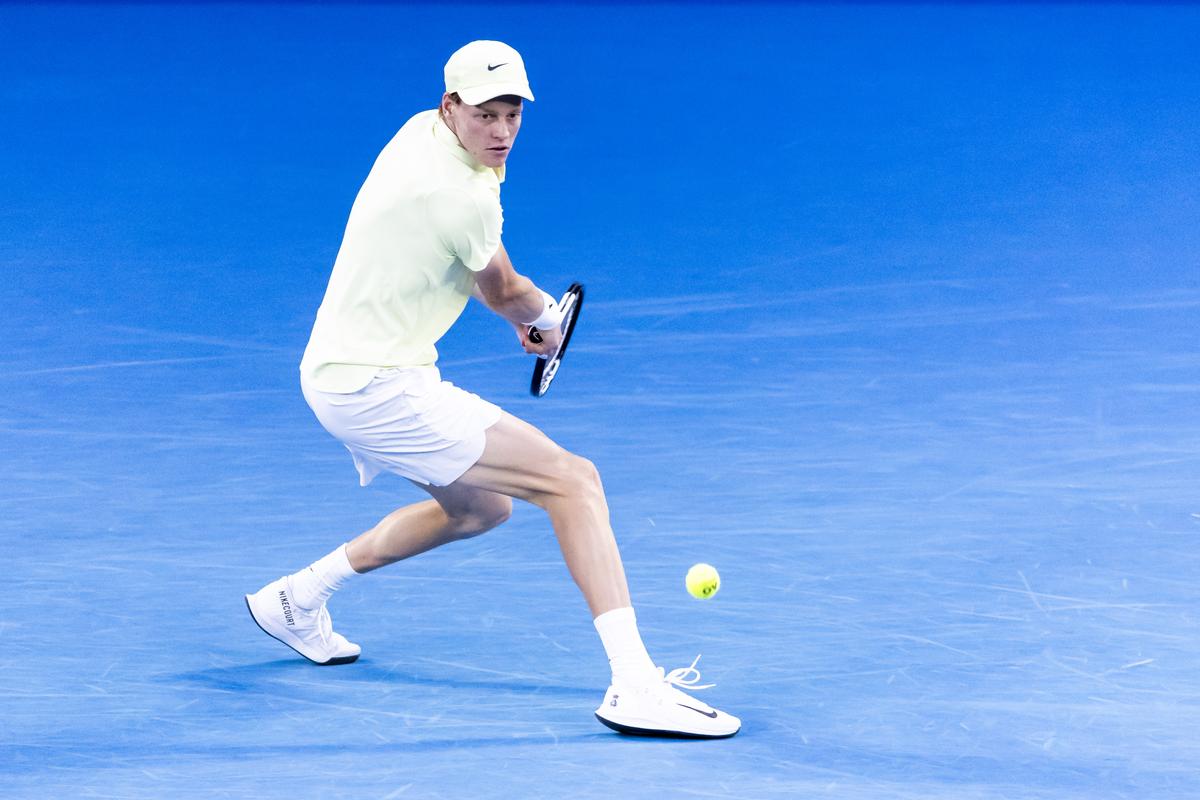
Hard-coded for success: Sinner’s repeatable technique is suited to truer surfaces. He has won the last three Slams to be held on synthetic courts. Former World No. 1 Andy Roddick likened him to an ‘algorithm’, ‘a piece of software that went: input output input output’. | Photo credit: Getty Images
| Photo Credit:
Getty Images
“The thing with Sinner is he strikes the ball so hard and also without making too many mistakes,” former World No. 1 Mats Wilander told ‘Tennis365’ recently. “That is too much for a lot of people, but not Alcaraz. When Sinner has a forehand and time to hit it, other players have to guess left or right. Carlos doesn’t have that problem as he is super fast.”
Thrust, parry, counter
All of which suggests that the two have areas to unlock and space to grow. Alcaraz did that most recently in the Rome final by pinning Sinner deep in his backhand corner and forcing the Italian to generate his own pace. The triumphant Spaniard later called it “tactically, my best match”. Sinner’s response will likely help write the next glorious chapter.
“I wake up in the morning trying to understand the ways to beat him [Alcaraz],” Sinner had said in October 2024 after the Six Kings Slam exhibition in Saudi Arabia. “These rivalries, these kinds of players, they always push us to our 100%. Hopefully this rivalry will last as long as possible.”
Published – June 07, 2025 03:14 pm IST
